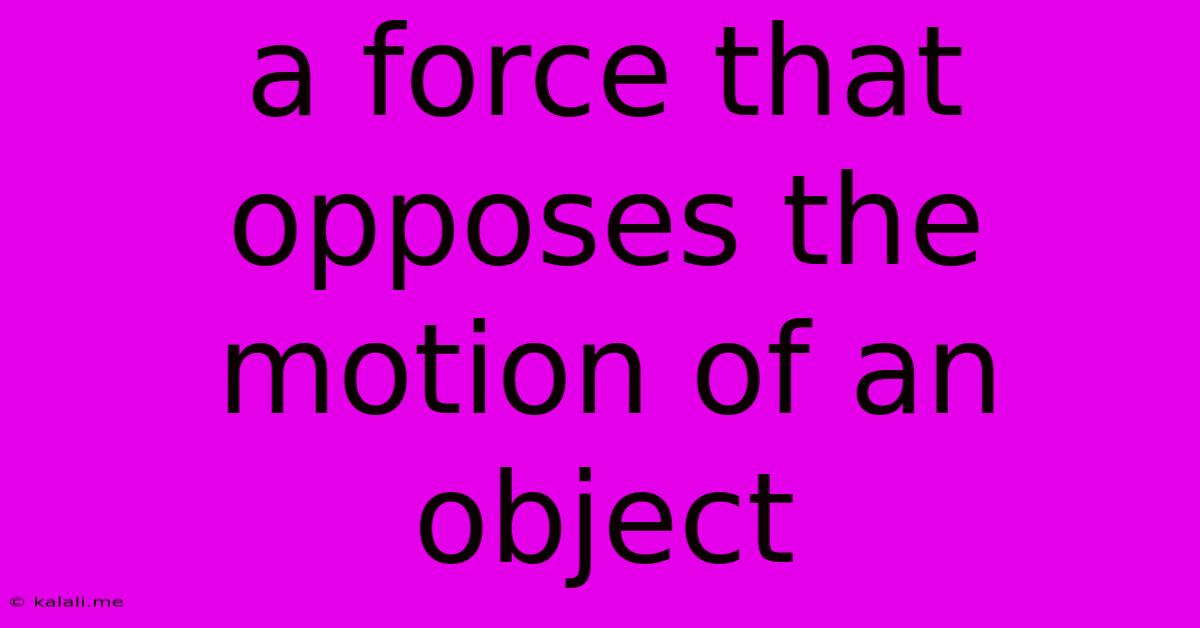A Force That Opposes The Motion Of An Object
Kalali
May 08, 2025 · 3 min read

Table of Contents
Understanding Friction: The Force That Opposes Motion
Friction is a force that resists the relative motion of surfaces in contact. It's a fundamental concept in physics, impacting everything from the simplest actions like walking to complex engineering challenges. This article will delve into the nature of friction, its types, and its significance in various aspects of our lives. Understanding friction is crucial for designing efficient machines, predicting the behavior of moving objects, and even appreciating the everyday world around us.
What Causes Friction?
At a microscopic level, surfaces appear smooth but are actually rough, with irregularities and imperfections. When two surfaces come into contact, these irregularities interlock, creating resistance to movement. The force of friction is the result of these microscopic interactions, including:
- Adhesion: The attractive forces between molecules of the two surfaces.
- Deformation: The slight changes in shape of the surfaces as they are pressed together.
- Plowing: The process of one surface effectively plowing through the irregularities of the other.
Types of Friction
Friction is broadly classified into several types:
-
Static Friction: This is the force that prevents two surfaces from moving relative to each other when a force is applied. It's the force you overcome when you start pushing a heavy object across the floor. Static friction is always greater than kinetic friction.
-
Kinetic Friction (or Sliding Friction): This is the force that opposes the motion of two surfaces sliding against each other. Once an object is in motion, the force of kinetic friction is generally constant.
-
Rolling Friction: This occurs when an object rolls over a surface, such as a wheel rolling on the ground. It is significantly less than sliding friction, which is why wheels are so efficient for transportation.
-
Fluid Friction (or Drag): This is the resistance encountered by objects moving through fluids (liquids or gases). The shape of the object and the viscosity of the fluid significantly affect the amount of fluid friction.
Factors Affecting Friction
Several factors influence the magnitude of the frictional force:
-
Nature of the surfaces: Rougher surfaces generally exhibit higher friction than smoother surfaces. The materials involved also play a crucial role; rubber on asphalt has higher friction than steel on ice.
-
Normal force: The force pressing the two surfaces together. The greater the normal force (e.g., a heavier object), the greater the frictional force.
-
Area of contact: Surprisingly, the area of contact between the two surfaces has minimal effect on the frictional force (except in the case of extremely small contact areas).
The Significance of Friction
While often seen as a resistive force, friction is essential for many everyday processes:
- Walking: Friction between your shoes and the ground prevents you from slipping.
- Driving: Friction between the tires and the road allows your car to move and brake.
- Writing: Friction between the pen and paper allows you to write.
- Braking: Friction in the brake pads slows down or stops moving vehicles.
Reducing Friction
In many applications, reducing friction is desirable to improve efficiency and reduce wear and tear. Methods for reducing friction include:
- Lubrication: Using lubricants like oil or grease reduces friction by creating a thin layer between the surfaces.
- Streamlining: Designing objects with smooth, aerodynamic shapes reduces fluid friction.
- Using rollers or bearings: Replacing sliding motion with rolling motion significantly reduces friction.
Friction is a ubiquitous force with both beneficial and detrimental effects. Understanding its nature and the factors that influence it is essential for countless applications in engineering, manufacturing, and everyday life. By understanding friction, we can design more efficient machines, improve transportation, and even enhance our understanding of the physical world.
Latest Posts
Latest Posts
-
Is Milk Is A Pure Substance
May 09, 2025
-
9 Out Of 17 As A Percentage
May 09, 2025
-
Choose The Best Lewis Structure For Ch2cl2
May 09, 2025
-
Where Is The Highest Electronegativity Found
May 09, 2025
-
What Percent Is 1 Out Of 12
May 09, 2025
Related Post
Thank you for visiting our website which covers about A Force That Opposes The Motion Of An Object . We hope the information provided has been useful to you. Feel free to contact us if you have any questions or need further assistance. See you next time and don't miss to bookmark.